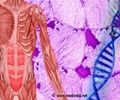
Startle disease, or hyperekplexia, emerges after birth, and while the symptoms usually diminish they sometimes continue into adulthood. The abnormal startle response is caused by glitches in glycine signaling.
Glycine is a small amino acid with various roles in the cell, one of which is to transmit inhibitory signals between nerve cells. In startle disease, defective proteins prevent cells from receiving the inhibitory signals that normally control a person's response to noise and touch. The result is the amplified, harmful response.
Startle disease is caused by mutations in multiple genes that encode proteins involved in glycine signaling. For example, one well-known cause is mutation of the glycine receptor alpha1 subunit gene.
But many cases do not involve that gene or the handful of others that have been given close scrutiny, according to Robert Harvey at University College London, one of the JBC authors. Working together with Mark Rees at the Institute of Life Science, Swansea University, another prominent cause of startle disease was discovered – mutations in the gene for a glycine transporter known as GlyT2.
Rees' group performed genetic analyses of 93 patients across the globe and identified 19 new recessive mutations in GlyT2. Experiments using molecular models and cell lines in Harvey's group showed that these mutations resulted either in the loss or reduction of glycine uptake by GlyT2.
Advertisement
In the other JBC paper, Beatriz López-Corcuera at the Universidad Autónoma de Madrid in collaboration with Cecilio Giménez and Pablo Lapunzina´s groups at the IdiPAZ-Hospital Universitario La Paz and colleagues report another novel genetic mutation in GlyT2 as the cause of startle disease in eight patients from Spain and the United Kingdom.
Advertisement
The team found that the mutation hindered proper expression of the GlyT2 transporter at the cell membrane and changed how GlyT2 itself functions.
López-Corcuera explains that this GlyT2 mutation reduces glycine uptake, which decreases the amount of glycine subsequently released and ultimately hinders transmission of the inhibitory signal. López-Corcuera suggests that these results may explain the symptoms observed in the patients and "could be useful for future pharmacological approaches."
Source-Eurekalert











